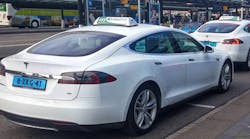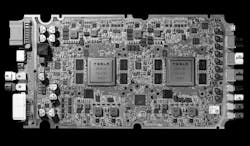Tesla’s Musk: Robo-Taxis Will be Available on U.S. Roads Next Year
Speaking at Tesla’s first Autonomy Day event, hosted in Palo Alto and designed to show off the company’s self-driving technology, CEO Elon Musk said Tesla expects to start converting its electric cars into fully self-driving vehicles in some markets next year. It’s part of a plan to create a network of robotic taxis to compete head-to-head against ride-hailing services such as Uber and Lyft. Musk further boasted that “probably two years from now, we’ll make a car with no steering wheels or pedals.”
In its ride-sharing vision, Tesla cars were not in use. Rather, Tesla would allow owners to put their cars into the service via their smartphones, with the company taking 25% to 30% of the fare. Tesla would provide vehicles in areas where not enough people share their cars.
Musk predicted that the company's system of computers, software, and neural-network object detection and depth recognition would get regulatory approval to operate in California toward the end of 2020.
Unlike self-driving cars from Uber, Waymo, Cruise, and others, Tesla vehicles rely on cameras and radar rather than LiDAR as part of their imaging system for autonomous driving. Taking aim at competitors relying on LiDAR-based sensors, Musk said, “LiDAR is a fools’ errand. And anyone relying on LiDAR is doomed,” adding “expensive sensors are unnecessary. It’s like having a whole bunch of expensive appendixes.”
Andrej Karparthy, Senior Director of AI at Tesla, explained that the world is built for visual recognition. LiDAR systems, he said, have a hard time puzzling out what’s a plastic trash bag and what’s a rubber tire. “In that sense, LiDAR is really a shortcut,” remarked Karparthy. “It sidesteps the fundamental problems, the important problem of visual recognition that is necessary for autonomy.”
Central to the Tesla system is a “full self-driving computer,” or FSDC. This consists of two duplicate systems next to each other on one board for redundancy, and thus safety purposes.
For redundancy, Tesla’s self-driving CPU has two chips on one board, each with its own power and storage systems.
A new custom chip, made by Samsung, will be running the self-driving software in Tesla vehicles. Tesla’s chip was capable of seven times as many frames as NVIDIA’s Xavier system, according to Pete Bannon, Tesla’s vice president of Autopilot engineering. NVIDIA subsequently disputed some of the claims made by Tesla in its presentation, saying that the electric-car maker was confusing a whole computer’s performance using multiple NVIDIA chips with that of one chip.
Large-scale neural-network training and visual recognition are necessary for Level 4 and Level 5 autonomy. Musk pointed out that the sensors inside Tesla vehicles lean on a neural network that’s trained by data collected by all Tesla vehicles.
He said Tesla’s self-driving software is storing images and learning at an exponential rate, citing the fact that this quarter Tesla will have 500,000 vehicles on the road. Each of these vehicles will be equipped with eight cameras, ultrasonic sensors, and radar gathering data to help its neural network, so that the vehicle can recognize images, determine what objects are, and figure out what to do.
It should be noted that Tesla uses the term “full self-driving” for an option available on its cars today that’s not yet SAE “Level 4” or “Level 5” (fully autonomous) by industry standards.
Last week in an interview on the podcast Recode Decode, Ford CTO Ken Washington said that to be ready for regular consumers, so-called robo-cars need to have a pre-existing 3D scan of every street they drive on. During the interview Washington threw a barb at Tesla’s Autopilot features. “That’s why these vehicles that don’t have LiDAR, that don’t have advanced radar, that haven’t captured a 3D map, are not self-driving vehicles. Let me just really emphasize that. They’re consumer vehicles with really good driver-assist technology,“ he said. Ford is currently testing its self-driving cars in Miami, Washington, Dearborn (Mich.), Pittsburgh, and several places in California.
Washington’s boss, Ford CEO Jim Hackett, who at one time was the head of the company’s autonomous vehicle division, said recently at an industry gathering in Detroit that “we overestimated the arrival of autonomous vehicles.” Ford still plans on launching its self-driving car fleet in 2021, he noted, but cautioned that it will be narrowly applied “what we call geo-fenced, because the problem is so complex.”


